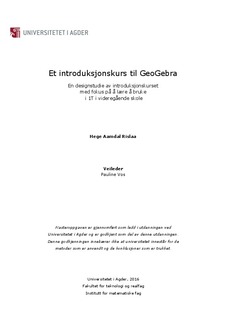| dc.description.abstract | As a teacher, I have observed over the past years a change in focus on the use of tools in the teaching of mathematics. Starting in spring 2015 the use of digital tools by students will be a requirement in the examinations in mathematics at high school level. This means that teachers must be even more aware of how we can best help our students to master the use of such tools while refining their understanding of mathematics.
The aim of my study was to find a way to introduce GeoGebra (a mathematical tool with options for dynamic geometry, for plotting functions, and for CAS) to students in grade 11. The introduction should be such that the students would take ownership of GeoGebra as a tool. To analyze how students can learn to use a tool effectively, I have chosen instrumental genesis as a theoretical framework for my study. Instrumental genesis is the process that makes available technology a powerful and effective tool. One must learn to use (instrumentation) before one can use to learn (instrumentalisation). Therefore, I developed and studied an introductory course on GeoGebra focusing on learning how to use the tool, in such a way that the students would become confident in using the tool.
My research questions were the following:
1) How do the students experience the usefulness of an introductory course on GeoGebra with a focus on learn to use?
2) What effect does a course that focuses on learn to use have on the students’ technical skills and on personal aspects?
3) How can an introductory course on GeoGebra with a focus on learn to use assist students in taking ownership over GeoGebra as a tool?
I have completed a Design Research, in which I developed an introductory course in GeoGebra focusing on learning how to use the tool, consisting of four lessons. The design approach was cyclic with three iterations: a first prototype received feedback from my own children; a second prototype was tested at my school with a pilot group. The third version of the material for the introductory course was used in the main study. The main study was carried out with approximately 200 grade 11 students (9 classes) at a secondary school in Kristiansand between September and October 2015. One class was my own. To increase the credibility of the results I have used a variety of qualitative methods to collect data during and after the four lessons: - Field notes, an observation report and audio recordings from my own class (27 students). - Students’ hand-in work on assignments (27 students). - A survey on students' evaluation of the course (approximately 160 students). - A focus group interview with 5 students . - A focus group interview with 4 teachers who implemented the course with their class. All data were analyzed on usefulness, technical skills, personal aspects and ownership. The results show that pupils appreciated the introduction with an emphasis on learn to use GeoGebra. Many of the students showed motivation to explore the tool. They became familiar with the user interface and many important features and buttons. There was evidence that the students started to become confident to adopt the tool, and they started the process of taking ownership over GeoGebra as a tool. Although the students said that they were uncertain of the usefulness, their teachers expressed clearly that the introduction course was useful, creating a basis so that GeoGebra can later become a tool to use for learning mathematics. | nb_NO |
